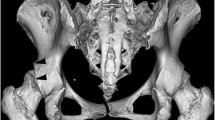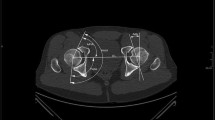Abstract
Purpose
Some patients with shoulder laxity complain of coxalgia without a history of trauma. We hypothesised that patients who have recurrent shoulder instability accompanied with generalised joint hyperlaxity tend to have acetabular dysplasia.
Methods
Pelvic radiographs of 26 young patients with hyperlaxity who had shoulder instability complaints without any history of hip joint trauma were evaluated by measuring their centre-edge angle (CEA) and acetabular angle (AA). In addition, Beighton generalised joint laxity tests were performed. All of the patients had shoulder pain and instability accompanied with hyperlaxity. We performed magnetic resonance imaging examination to show SLAP-Bankart lesions and pelvis anteroposterior X-rays to detect acetabular dysplasia.
Results
The average age of the study group was 26 ± 8.03 years (13-39). Six patients were female and 20 were male. When CEA (<22.6 degrees) was used as a criterion for acetabular dysplasia, the dysplasia rate of our patient group was 3.84 % for the right hip, 3.84 % for the left hip and 3.84 % overall. When AA (>42.2 degrees) was used as the dysplasia criterion, the dysplasia rate of patient group was 30.76 % for the right hip, 57.69 % for the left hip and 57.69 % overall.
Conclusions
CEA values were significantly lower (p = 0.009) and AA values were significantly higher (p < 0.001) in our study group than the previously-reported average values of the Turkish population. We think that acetabular dysplasia is more frequent in patients with hyperlaxity; further studies are needed to test this idea.



Similar content being viewed by others
References
Herring JA (2008) Developmental dysplasia of hip. In: Tachdjian’s pediatric orthopaedics, 3rd edn. Saunders/Elsevier, Philadelphia, pp 637-647
Wynne-Davies R (1970) Acetabular dysplasia and familial joint laxity: two etiological factors in congenital dislocation of the hip, a review of 589 patients and their families. J Bone Joint Surg (Br) 52(4):704–716
Idleberger K (1951) The genetic pathology of so-called CDH. Urban & Schwarzenberg, Munich
Coleman SS (1968) Congenital dysplasia of the hip in the Navajo infant. Clin Orthop Relat Res 56:179
Jensen BA, Reimann I, Fredensborg N (1986) Collagen type III predominance in newborns with congenital dislocation of the hip. Acta Orthop Scand 57:362
Andren L (1962) Pelvic instability in newborns with special reference to congenital dislocation of the hip and hormonal factors: a roentgenologic study. Acta Radiol Suppl 212:1–66
Sharp I (1961) Acetabular dysplasia: the acetabular angle. J Bone Joint Surg (Br) 43-B:268–272
Beighton P, Solomon L, Soskolne CL (1973) Articular mobility in an african population. Ann Rheum Dis 32:413–418
Aktas S, Pekindil G, Ercan S, Pekindil Y (2000) Acetabular dysplasia in normal Turkish adults. Bull Hosp Jt Dis 59(3):158–162
Inoue K, Wicart P, Kawasaki T, Huang J, Ushiyama T, Hukuda S et al (2000) Prevalence of hip osteoarthritis and acetabular dysplasia in French and Japanese adults. Rheumatology (Oxford) 39(7):745–748
Yoshimura N, Campbell L, Hashimoto T, Kinoshita H, Okayasu T, Wilman C et al (1998) Acetabular dysplasia and hip osteoarthritis in Britain and Japan. Br J Rheumatol 37(11):1193–1197
Lau EM, Lin F, Lam D, Silman A, Croft P (1995) Hip osteoarthritis and dysplasia in Chinese men. Ann Rheum Dis 54(12):965–969
Nakamura S, Ninomiya S, Nakamura T (1989) Primary osteoarthritis of the hip joint in Japan. Clin Orthop Relat Res (241):190-196
Wiberg G (1939) Studies on dysplastic acetabula and congenital subluxation of the hip joint: with special reference to the complication of osteoarthritis. Acta Chir Scand 83(58):5–135
Cooperman DR, Wallensten R, Stulberg SD (1983) Acetabular dysplasia in the adult. Clin Orthop Relat Res 175:79–85
Fredensborg N (1976) The results of early treatment of typical congenital dislocation of the hip in Malmo. J Bone Joint Surg (Br) 58:272–278
Garbuz DS, Masri BA, Haddad F, Duncan CP (2004) Clinical and radiographic assessment of the young adult with symptomatic hip dysplasia. Clin Orthop Relat Res 418:18–22
Andren L (1961) Aetiology and diagnosis of congenital dislocation of the hip in newborns. Radiologe 1:89–94
Carter C, Wilkinson J (1964) Persistent joint laxity and congenital dislocation of the hip. J Bone Joint Surg (Br) 46:40–45
Yamazaki J, Muneta T, Ju YJ, Morito T, Okuwaki T, Sekiya I (2011) Hip acetabular dysplasia and joint laxity of female anterior cruciate ligament-injured patients. Am J Sports Med 39(2):410–414. doi:10.1177/0363546510381588
Murray RO (1965) The aetiology of primary osteoarthritis of the hip. Br J Radiol 38(455):810–824
Goker B, Sancak A, Haznedaroglu S (2005) Radiographic hip osteoarthritis and acetabular dysplasia in Turkish men and women. Rheumatol Int 25(6):419–422
Author information
Authors and Affiliations
Corresponding author
Ethics declarations
Conflıct of interest
None.
Rights and permissions
About this article
Cite this article
Bilsel, K., Ceylan, H.H., Yıldız, F. et al. Acetabular dysplasia may be related to global joint hyperlaxity. International Orthopaedics (SICOT) 40, 885–889 (2016). https://doi.org/10.1007/s00264-015-3004-3
Received:
Accepted:
Published:
Issue Date:
DOI: https://doi.org/10.1007/s00264-015-3004-3




